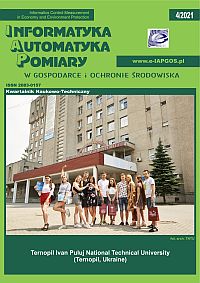O POJEMNOŚCI OGNIW FOTOWOLTAICZNYCH W WARUNKACH CZĘŚCIOWEGO ZACIEMNIENIA
##plugins.themes.bootstrap3.article.sidebar##
Open full text
Numer Tom 11 Nr 4 (2021)
-
CAŁKI OSOBLIWE W METODZIE ELEMENTÓW BRZEGOWYCH DLA RÓWNANIA HELMHOLTZA SFORMUŁOWANEGO W PRZESTRZENI CZĘSTOTLIWOŚCI
Tomasz Rymarczyk, Jan Sikora4-8
-
ZASTOSOWANIE PLATFORM THREAT INTELLIGENCE DO ZWIĘKSZENIA OCHRONY ZASOBÓW INFORMACJI PUBLICZNEJ
Bohdan Nikolaienko, Serhii Vasylenko9-13
-
TECHNOLOGIA POŚREDNIEGO UKRYWANIA INFORMACJI NA ZASADZIE MULTIADYCZNEJ
Volodymyr Barannik, Natalia Barannik, Oleksandr Slobodyanyuk14-17
-
WYBRANE ZASTOSOWANIA GŁĘBOKICH SIECI NEURONOWYCH W DIAGNOZIE ZMIAN SKÓRNYCH
Magdalena Michalska18-21
-
EFEKTYWNA METODA WYKRYWANIA LINII Z WYKORZYSTANIEM KONWOLUCYJNEGO FILTRU 2D
Paweł Kowalski, Piotr Tojza22-27
-
ZASTOSOWANIE METODY ANALIZY CZYNNIKOWEJ DO KONSTRUOWANIA FUNKCJI CELU OPTYMALIZACJI W PROBLEMACH TRANSPORTU MULTIMODALNEGO
Serhii Zabolotnii, Artem Honcharov, Sergii Mogilei28-31
-
DOKŁADNOŚĆ KOMUNIKACJI SATELITARNEJ W WYBRANYCH MOBILNYCH SMARTFONACH ANDROID
Przemysław Falkowski-Gilski32-37
-
KOMPENSACJA DYSPERSJI CHROMATYCZNEJ W ISTNIEJĄCYCH ŚWIATŁOWODOWYCH LINIACH TELEKOMUNIKACYJNYCH Z ROSNĄCYM ZAPOTRZEBOWANIEM PRZEPŁYWNOŚCI W SYSTEMACH DWDM
Tomasz Bobruk38-41
-
ŚWIATŁOWODOWE STRUKTURY BRAGGA O MONOTONICZNEJ CHARAKTERYSTYCE APODYZACJI
Jacek Klimek42-46
-
O POJEMNOŚCI OGNIW FOTOWOLTAICZNYCH W WARUNKACH CZĘŚCIOWEGO ZACIEMNIENIA
Mateusz Bartczak47-50
-
STEROWANIE CZTEROPRZEWODOWYM TRÓJPOZIOMOWYM PRZEKSZTAŁTNIKIEM AC/DC Z NIEZALEŻNĄ KONTROLĄ MOCY W KAŻDEJ Z FAZ
Bartłomiej Stefańczak51-54
-
METODA POMIARU I REDUKCJI ZABURZEŃ ELEKTROMAGNETYCZNYCH INDUKOWANYCH PRZEZ PRZEPIĘCIA ŁĄCZENIOWE W OBWODACH nN
Patryk Wąsik55-61
-
ZWIĘKSZENIE EFEKTYWNOŚCI KOSZTOWEJ PROWADZENIA BADAŃ IN VITRO POPRZEZ ZASTOSOWANIE TYTANU W URZĄDZENIU DO POMIARU PARAMETRÓW ELEKTRYCZNYCH KOMÓREK
Dawid Zarzeczny62-66
-
ELIPSOMETRYCZNY SYSTEM SPEKTROSKOPOWY DO SZYBKIEJ OCENY SKŁADU CIENKICH WARSTW Bi2Te3-XSeX
Vladimir Kovalev, Saygid Uvaysov, Marcin Bogucki67-74
-
WYKORZYSTANIE NISKOBUDŻETOWYCH CZUJNIKÓW STĘŻENIA CZĄSTECZEK W CELU POMIARU ZANIECZYSZCZEŃ POWSTAJĄCYCH W TRAKCIE PRACY DRUKAREK 3D
Jarosław Tatarczak75-77
Archiwum
-
Tom 13 Nr 4
2023-12-20 24
-
Tom 13 Nr 3
2023-09-30 25
-
Tom 13 Nr 2
2023-06-30 14
-
Tom 13 Nr 1
2023-03-31 12
-
Tom 12 Nr 4
2022-12-30 16
-
Tom 12 Nr 3
2022-09-30 15
-
Tom 12 Nr 2
2022-06-30 16
-
Tom 12 Nr 1
2022-03-31 9
-
Tom 11 Nr 4
2021-12-20 15
-
Tom 11 Nr 3
2021-09-30 10
-
Tom 11 Nr 2
2021-06-30 11
-
Tom 11 Nr 1
2021-03-31 14
-
Tom 10 Nr 4
2020-12-20 16
-
Tom 10 Nr 3
2020-09-30 22
-
Tom 10 Nr 2
2020-06-30 16
-
Tom 10 Nr 1
2020-03-30 19
-
Tom 9 Nr 4
2019-12-16 20
-
Tom 9 Nr 3
2019-09-26 20
-
Tom 9 Nr 2
2019-06-21 16
-
Tom 9 Nr 1
2019-03-03 13
##plugins.themes.bootstrap3.article.main##
DOI
Authors
Abstrakt
System fotowoltaiczny w warunkach równomiernego oświetlenia ma tylko jeden globalny punkt mocy maksymalnej, ale ten sam panel w przypadku warunków częściowego zacienienia może mieć więcej maksimów na krzywej moc-napięcie. Autor przedstawia symulacje i wyniki pomiarów systemu fotowoltaicznego w różnych warunkach oświetlenia. Przedstawiono wpływ pojemności nieliniowej na kształt odpowiedzi na wzbudzenie w postaci obciążenia. W artykule opisano również jakie parametry ogniwa fotowoltaicznego wpływają na kształt krzywej C-V. Autor proponuje analizę odpowiedzi napięciowej systemu w celu wydobycia informacji o stanie częściowego zacienienia.
Słowa kluczowe:
Bibliografia
Azzouzi M. et al.: Modeling of electrical characteristics of photovoltaic cell considering single-diode model. Journal of Clean Energy Technologies 4(6), 2016, 414–420. DOI: https://doi.org/10.18178/JOCET.2016.4.6.323
Barro F. I. et al.: On the capacitance of crystalline silicon solar cells in steady state. Turkish Journal of Physics 39(2), 2015, 122–127. DOI: https://doi.org/10.3906/fiz-1408-3
Bollipo R. B. et al.: Critical review on PV MPPT techniques: classical, intelligent and optimisation. IET Renewable Power Generation 14(9), 2020, 1433–1452.
Bollipo R. B. et al.: Critical review on PV MPPT techniques: classical, intelligent and optimisation. IET Renewable Power Generation 14(9), 2020, 1433–1452. DOI: https://doi.org/10.1049/iet-rpg.2019.1163
Bubovich A.: The comparison of different types of DC-DC converters in terms of low-voltage implementation. 5th IEEE Workshop on Advances in Information, Electronic and Electrical Engineering (AIEEE), 2017, 1–4 [http://doi.org/10.1109/AIEEE.2017.8270560]. DOI: https://doi.org/10.1109/AIEEE.2017.8270560
Burgelman M. et al.: Modelling polycrystalline semiconductor solar cells. Thin solid films 361, 2000, 527–532. DOI: https://doi.org/10.1016/S0040-6090(99)00825-1
Cozzi L. et al.: World Energy Outlook 2020 – IEA, Organization for Economic Co-operation and Development (OECD) / IEA, Paris, France, 2020 [https://www.iea.org/reports/world-energy-outlook-2020] (available: 10.10.2021).
Danoune M. B. et al.: Study and performance analysis of three conventional MPPT algorithms used in photovoltaic applications. International Conference on Communications and Electrical Engineering (ICCEE). IEEE, 2018. DOI: https://doi.org/10.1109/CCEE.2018.8634524
Davies L. et al.: Automatic detection and characterization of partial shading in PV system. IEEE 7th World Conference on Photovoltaic Energy Conversion (WCPEC) (A Joint Conference of 45th IEEE PVSC, 28th PVSEC & 34th EU PVSEC), 2018. DOI: https://doi.org/10.1109/PVSC.2018.8548279
Fadliondi F. et al.: Bypass diodes for improving solar panel performance. International Journal of Electrical and Computer Engineering 8(5), 2018, 2703. DOI: https://doi.org/10.11591/ijece.v8i5.pp2703-2708
Franjo P., Virtič P.: Power production comparison of photovoltaic modules. Przegląd Elektrotechniczny 90(12), 2014, 284–287 [http://doi.org/10.12915/pe.2014.12.72].
Humada A. M. et al.: Solar cell parameters extraction based on single and double-diode models: A review. Renewable and Sustainable Energy Reviews 56, 2016, 494–509. DOI: https://doi.org/10.1016/j.rser.2015.11.051
Mekki H. et al.: Artificial neural network-based modelling and fault detection of partial shaded photovoltaic modules. Simulation Modelling Practice and Theory 67, 2016, 1–13. DOI: https://doi.org/10.1016/j.simpat.2016.05.005
Rhouma M. B. H. et al.: A simple method for extracting the parameters of the PV cell single-diode model. Renewable Energy 113, 2017, 885–894. DOI: https://doi.org/10.1016/j.renene.2017.06.064
Shannan N. M. et al.: Single-diode model and two-diode model of PV modules: A comparison. IEEE International Conference on Control System, Computing and Engineering, 2013.
Singh S. P. et al.: Performance comparison of MPPT techniques using Cuk converter for photovoltaic energy conversion system. 3rd International Conference on Computational Intelligence & Communication Technology (CICT), 2017, 1–6 [http://doi.org/10.1109/CIACT.2017.7977369]. DOI: https://doi.org/10.1109/CIACT.2017.7977369
##plugins.themes.bootstrap3.article.details##
Abstract views: 436
Licencja

Utwór dostępny jest na licencji Creative Commons Uznanie autorstwa – Na tych samych warunkach 4.0 Miedzynarodowe.






